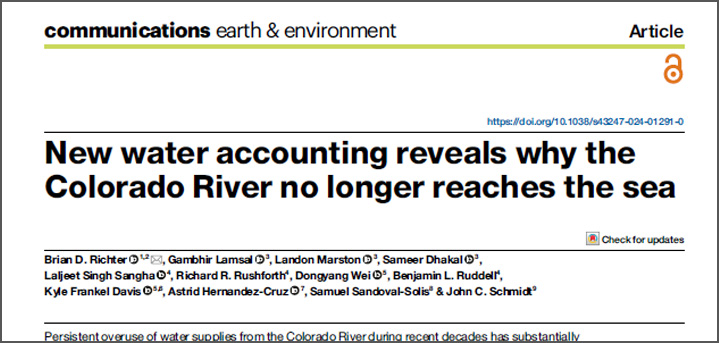Richter, B.D., Lamsal, G., Marston, L. et al. New water accounting reveals why the Colorado River no longer reaches the sea. Commun Earth Environ 5, 134 (2024). https://doi.org/10.1038/s43247-024-01291-0
Communications earth & environment full article here.
Posting on X by Springer Nature including the video:
Posting on X here
Irrigation for agriculture uses more than half of Colorado River’s total annual water flow. This finding provides understanding of how the river’s water is used. Read the OA article: https://nature.com/articles/s43247-024-01291-0?utm_medium=social&utm_content=organic&utm_source=twitter&utm_campaign=SMT_&sf272699159=1… @CommsEarth @QCNRUSU, @NAU, @virginia_tech, @UDelaware, @World_Wildlife
Irrigation for agriculture uses more than half of Colorado River’s total annual water flow. This finding provides understanding of how the river’s water is used. Read the OA article: https://t.co/pwU5uKJGsD@CommsEarth @QCNRUSU, @NAU, @virginia_tech, @UDelaware, @World_Wildlife pic.twitter.com/NfrdyhMX8S
— Springer Nature (@SpringerNature) April 26, 2024
Abstract
Persistent overuse of water supplies from the Colorado River during recent decades has substantially depleted large storage reservoirs and triggered mandatory cutbacks in water use. The river holds critical importance to more than 40 million people and more than two million hectares of cropland. Therefore, a full accounting of where the river’s water goes en route to its delta is necessary. Detailed knowledge of how and where the river’s water is used can aid design of strategies and plans for bringing water use into balance with available supplies. Here we apply authoritative primary data sources and modeled crop and riparian/wetland evapotranspiration estimates to compile a water budget based on average consumptive water use during 2000–2019. Overall water consumption includes both direct human uses in the municipal, commercial, industrial, and agricultural sectors, as well as indirect water losses to reservoir evaporation and water consumed through riparian/wetland evapotranspiration. Irrigated agriculture is responsible for 74% of direct human uses and 52% of overall water consumption. Water consumed for agriculture amounts to three times all other direct uses combined. Cattle feed crops including alfalfa and other grass hays account for 46% of all direct water consumption.

